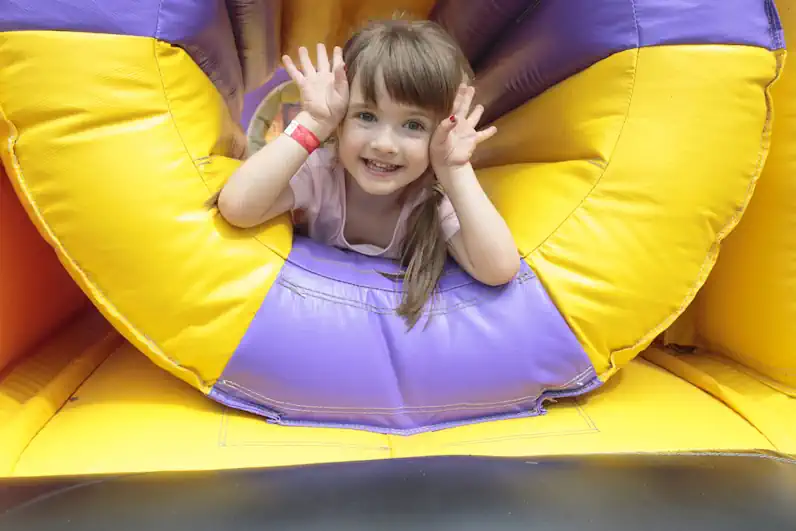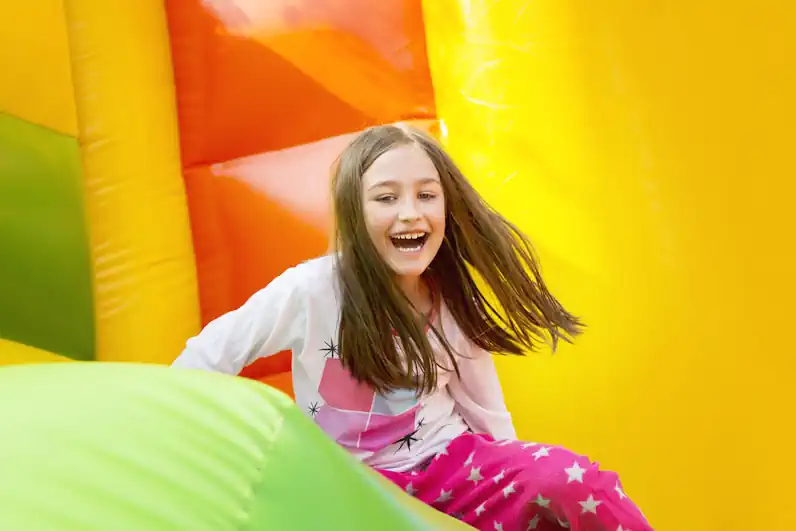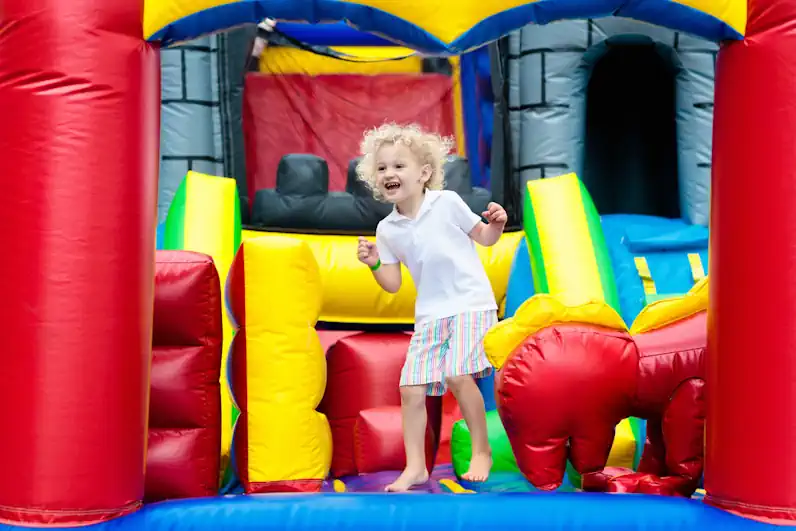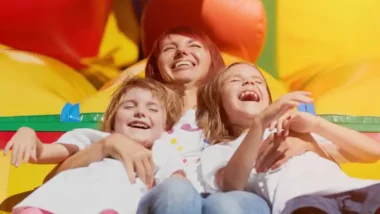Do your kids love bouncy houses? Do they beg to go to parties or events just for the chance to jump around in one? You’re not alone.

Many parents have noticed that their children are completely enamored with these inflatable structures. But have you ever wondered why?
As it turns out, there’s actually some science behind why kids love bouncy houses so much. From the physical sensation of bouncing to the social interaction and play that comes with it, there are a number of factors at play.
And as a parent, understanding these factors can not only help you better appreciate your child’s love of bouncy houses, but also help you make informed decisions about when and where they should be allowed to play in them.
So let’s dive in and explore the reasons why bouncy houses are such a hit with kids.
The Physical Sensation of Bouncing
You can’t help but feel a rush of excitement as you bounce up and down in a bouncy house. The physical sensation of the soft, squishy material beneath you adds to the thrill. This feeling is not just in your head; it’s actually a result of the bouncy house providing proprioception benefits.
Proprioception is the sense of your body’s position and movement in space. Bouncing in a bouncy house gives your body a chance to experience this sense in a fun and unique way. In addition to proprioception benefits, bouncing also provides vestibular stimulation.
The vestibular system is responsible for balance and spatial orientation. Bouncing up and down in a bouncy house activates this system in a way that is different from other types of movement. This stimulation can lead to improved balance and coordination, making it a great activity for kids to engage in.
The physical sensation of bouncing in a bouncy house is not only fun but also beneficial for kids’ development.
Safety and Reduced Risk of Injury
You’re probably wondering about the safety of bouncy houses, and we’re here to tell you that inflatable play structures are actually one of the safest types of play equipment out there.
One reason for this is the soft, inflatable surface that cushions any falls or bumps. Also, the enclosed nature of bouncy houses gives kids a sense of safety and security while they play.
Soft Inflatable Surface
With its soft and bouncy surface, the inflatable material of bouncy houses provides a fun and safe play environment for children.
Not only is it enjoyable to jump around and feel the sensation of bouncing, but the sensory stimulation provided by the bouncy house can also aid in cognitive development for children.
As children jump, they’re using their senses to understand their surroundings and develop a sense of balance and spatial awareness.

Bouncing is Good For a Child’s Physical Health, Too
Bouncing on a soft surface can also be beneficial for children’s physical health.
Jumping on a trampoline or bouncy house can strengthen muscles and improve cardiovascular health.
In fact, a study conducted by NASA found that bouncing on a trampoline, or in a bouncy house, for just 10 minutes is equivalent to running for 33 minutes.
With the added benefit of a soft surface, parents can rest assured that their children are having fun while also engaging in physical activity that’s beneficial for their health.
Sense of Safety
Feeling safe is essential for children’s enjoyment while playing, and that’s why bouncy houses are designed with high walls and safety nets to ensure a worry-free experience. This psychological comfort is crucial for children as they explore the world around them and develop their sense of independence.
A sense of security is also created by the bouncy house’s soft, inflatable surface, which cushions falls and reduces the risk of injury. To further enhance the perceived security of bouncy houses, they are often installed in enclosed spaces, such as backyards or indoor play centers. This creates a sense of containment, allowing children to play freely without worrying about wandering off or getting lost.
Bouncy houses are often supervised by adults who make sure that children are playing safely and following the rules. Overall, the sense of safety provided by bouncy houses plays a significant role in why kids love them so much. This allows them to let loose, have fun, and be themselves without any worries.
As a parent or caregiver, providing a safe and secure environment for children to play is essential for their physical and emotional well-being, and bouncy houses are a great way to do just that.
Social Interaction and Play
Did you know that bouncing around in a bouncy house with friends can actually improve social skills and encourage imaginative play? That’s right!
Bouncy houses provide a fun and safe environment for children to interact with one another and engage in imaginative games. When kids play together in a bouncy house, they’re forced to communicate and cooperate with one another, which can help build important social skills.
The freedom to jump, roll, and flop around in a bouncy house can encourage creative play and spark the imagination. Kids can invent their own games, create their own rules, and explore new ways to move their bodies.
This type of unstructured play is essential for developing problem-solving skills and fostering creativity. So, the next time your child begs to go to a bouncy house party, remember that it’s not just about the fun – it’s also helping them build important social and imaginative skills.
Physical Benefits
You’ll be amazed at how much better your body will feel after just a few minutes of jumping in a bouncy house. Not only is it fun, but it also provides numerous physical benefits. One of the main benefits is muscle development. Jumping on a bouncy surface requires the use of various muscle groups, such as the legs, arms, and core. This results in improved muscle strength and tone, which is essential for overall health and well-being.
Bouncing in a bouncy house also helps with sensory integration. It provides a unique sensory experience that stimulates the vestibular system, which is responsible for balance and spatial orientation.
The act of jumping and bouncing also helps improve proprioception, which is the body’s ability to sense its position and movements in space. This is particularly important for children with sensory processing issues, as it helps to improve their sensory integration skills and overall physical coordination. Check out the table below to see the different physical benefits of bouncing in a bouncy house:
| Physical Benefits of Bouncing in a Bouncy House | Result |
|---|---|
| Muscle Development | Improved muscle strength and tone |
| Sensory Integration | Stimulates the vestibular system |
| Proprioception | Improves body awareness and coordination |
| Cardiovascular Fitness | Increases heart rate and improves cardiovascular health |
Mental and Emotional Benefits
Jumping in a bouncy house can provide a boost to your mental and emotional well-being by releasing endorphins and reducing stress. Here are three ways in which bouncing around in a bouncy house can help with your cognitive development and emotional regulation:
- Improves focus and attention: Studies have shown that physical activity, such as jumping in a bouncy house, can help improve focus and attention in children. This is because physical activity increases blood flow to the brain, which in turn enhances cognitive function.
- Reduces stress and anxiety: Jumping in a bouncy house can help reduce stress and anxiety levels. This is because physical activity releases endorphins, which are natural mood boosters that can help counteract feelings of anxiety and stress.
- Enhances emotional regulation: Jumping in a bouncy house can help children learn to regulate their emotions. This is because physical activity helps release pent-up energy and emotions, which can help children feel calmer and more in control of their emotions.
Overall, bouncing in a bouncy house can have a positive impact on your mental and emotional well-being, making it a fun and healthy activity for all ages.

Summing Up
Now that you understand the science behind why kids love bouncy houses so much, it’s time to reflect on the joy and happiness these inflatable structures bring to children.
It’s remarkable how something as simple as bouncing can have such a profound impact on a child’s physical, mental, and emotional well-being.
On one hand, you have the physical benefits of bouncing, such as improving balance and coordination, increasing cardiovascular health, and developing gross motor skills.
On the other hand, you have the mental and emotional benefits, such as reducing stress and anxiety, promoting creativity and imagination, and fostering social interaction and play.
It’s no wonder that kids can’t get enough of bouncy houses. They provide a safe and fun environment where children can be themselves, let loose, and simply have fun.
As parents and caregivers, it’s important that we recognize the value of these inflatable structures and the positive impact they can have on a child’s life.
So, the next time you see a group of kids bouncing away in a bouncy house, take a moment to appreciate the joy and happiness they’re experiencing, and perhaps even join in on the fun yourself.
